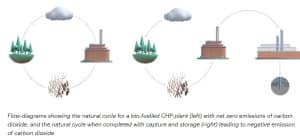Microsoft and the Swedish energy company Stockholm Exergi have announced a 10-year offtake agreement on May 6, 2024. Under this deal, Stockholm Exergi will provide Microsoft with over 3.3 MT of carbon removal certificates from its planned bio-energy with carbon capture and storage (BECCS) project at Värtan in Stockholm.
This historic agreement is believed to be the world’s largest permanent removal deal to date. Let’s deep dive into this significant announcement in this upcoming content.
Microsoft Commits to 10-Year Partnership with Stockholm Exergi
This collaboration aligns with Microsoft’s goal to be carbon-negative by 2030 and its commitment to climate change. The deal also supports its strategy of prioritizing emissions reductions while building a portfolio of carbon removal projects. In recent months, Microsoft has announced several CDR projects using various technologies and methods. Some include reforestation, direct air capture (DAC), ocean-based carbon removal, and biochar projects.
Microsoft reports new additions to its carbon removal portfolio. They are:
- Low-durability solutions: five forestry projects (>1.8 million mtCO2), one soil carbon project (200,000 mtCO2), and a mangrove blue carbon project (100,000 mtCO2). These solutions sequester carbon for less than 100 years, with forestry and soil approaches at the center. Although some forestry projects in the portfolio have contracted durability of 100 years or more, Microsoft categorizes them as low durability due to inherent reversal risks.
- Medium-durability solutions: three biochar projects (>81,000 mtCO2) and one kelp-sinking project (12,000 mtCO2). These solutions lock away carbon for 100-1,000 years. Biochar stands as the primary, established medium-durability method.
- High-durability solutions: one BECCS project (>2.67 million mtCO2), one CO2 mineralization project (25,000 mtCO2), three DAC projects (~12,000 mtCO2), and two ERW projects (>5,000 mtCO2). These solutions sequester carbon for thousands of years. The best-known methods include biomass with geologic storage, direct air capture, and mineralization.
Supporting this move, Brian Marrs, Microsoft’s senior director of energy and carbon removal has commented,
“Leveraging existing biomass power plants is a crucial first step to building worldwide carbon removal capacity.”
Notably, the tech giant is investing $1 billion inclusively into a new Climate Innovation Fund to accelerate CDR technologies, aiming to achieve global carbon negativity.
Stockholm Exergi’s Ambitious Carbon Capture Project
The Swedish company, which supplies power to Stockholm’s residents, plans to build a carbon capture and storage facility that will permanently remove 800,000 metric tons of CO2 annually.
Stockholm Exergi will begin construction in 2025 and will deliver the carbon removal certificates to Microsoft in 2028, continuing for a decade. The company further plans to seek complementary state aid and additional private carbon removal deals. It’s essential for reaching the financial closure.
Anders Egelrud, the CEO of Stockholm Exergi noted,
“The agreement with Microsoft is a huge step forward for our BECCS project, Stockholm Exergi as a company and the climate. It will inspire corporations with ambitious climate objectives, and we target to announce more deals with other pioneering companies over the coming months.”

Europe’s Largest BECCS (Bio-Energy and Carbon Capture Storage) Plant
Stockholm Exergi reports that the company obtained the environmental permit for the project in Stockholm on March 28th this year. The new carbon capture project will be integrated into Stockholm Exergi’s biomass and heat power plant, operational since 2016.
The Stockholm Exergi KVV8 facility is Europe’s largest biomass-based Combined Heat and Power plant. This plant burns waste from the forestry industry and paper mills to generate heat and electricity.
The significant features of this project are:
- It will safeguard the biomass feedstock to ensure sustainable forest management and protect sensitive areas.
- It will maintain stable carbon stocks and ensure that feedstock is not sourced from Roundwood for long-lived wood products.
- Permanent geological storage will occur in the Nordic region.
Carbon Capture and Storage Process
The plant will capture the carbon dioxide released during incineration, liquefy it for transport, and permanently store it underground. The project will adhere to stringent quality standards, including sustainable biomass sourcing and comprehensive monitoring, reporting, and verification (MVR) protocols.
Milestone for Climate Change Mitigation
The contract marks a significant step toward climate change mitigation. While reducing emissions remains a top priority, permanent carbon removals are integral to limiting global warming to 1.5°C or well below 2°C.
By committing to ambitious, voluntary corporate climate objectives, Microsoft and Stockholm Exergi aim to foster the growth of the carbon removal industry. The deal would set an example to help companies globally meet net-zero targets and achieve the Paris Agreement goals.

